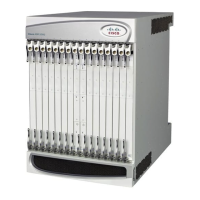ASR 5000 Hardware Platform Overview
▄ ASR 5000 Installation Guide
10/100/1000 Mbps Ethernet Management LAN Interfaces—Two RJ-45 interfaces, supporting 10/100 Mbps or 1
Gbps Ethernet.
Console Port—RJ-45 interface used for local connectivity to the command line interface (CLI).
BITS Timing Interface (Optional) —Either an analog E1 BNC coaxial connector or T1 (DS-1) 3-pin wire-wrap
connector. Used for application services that use either the OLC2 or CLC2 line cards.
CO Alarm Interface—Dry contact relay switches, allowing connectivity to central office, rack, or cabinet alarms.
Management LAN Interfaces
SPIO management LAN interfaces connect the system to the carrier’s management network and applications, normally
located remotely in a Network Operations Center (NOC). You can use the RJ-45 copper 10/100/1000 Mbps Ethernet
interfaces or optical SFP Gigabit Ethernet interfaces to connect to the management network.
When using the RJ-45 interfaces, use CAT5 shielded twisted pair (STP) cabling.
Important: Use shielded cabling whenever possible to further protect the chassis and its installed components
from ESD or other transient voltage damage.
Table 9. SFP Interface Supported Cable Types
Fiber, LC duplex
female connector
Fiber Type: Multi-mode fiber (MMF), 850 nm wavelength
Core Size (microns)/Range:
62.5/902.23 feet (275 meters)
50/1640.42 feet (500 meters)
Minimum Tx Power: -9.5 dBm
Rx Sensitivity: -17 dBm
Console Port
The console uses an RS-232 serial communications port to provide local management access to the command line
interface (CLI). A 9-pin-to-RJ-45 console cable is supplied with each SPIO card. The console cable must provide
carrier-detect when attached in a null modem configuration.
Should connection to a terminal server or other device requiring a 25-pin D-subminiature connector be required, a
specialized cable can be constructed to support DB-25 to RJ-45 connectivity. The baud rate for this interface is
configurable between 9600 bps and 115,200 bps (default is 9600 bps).

